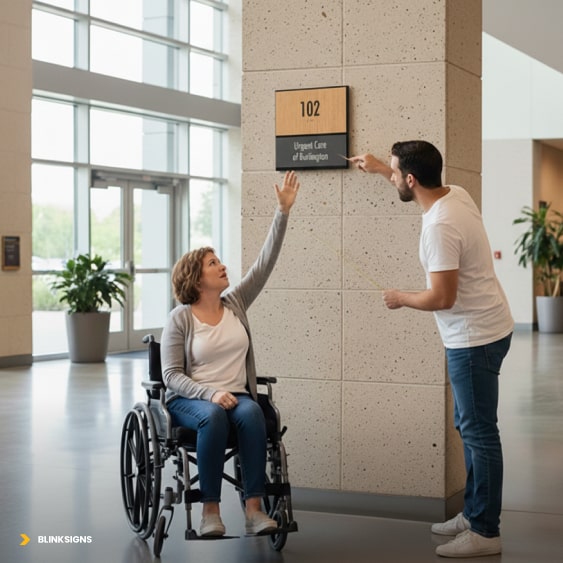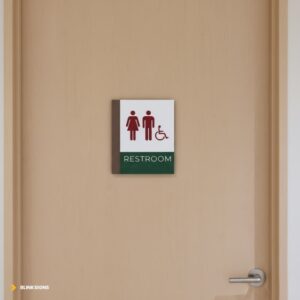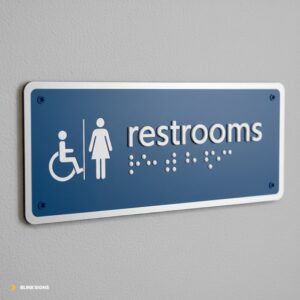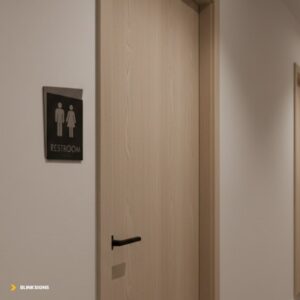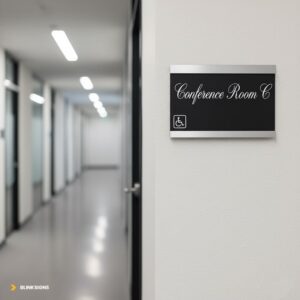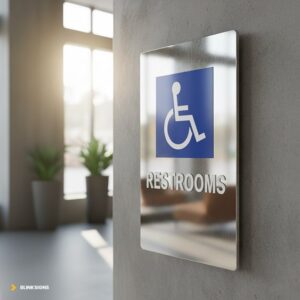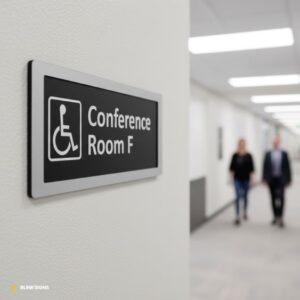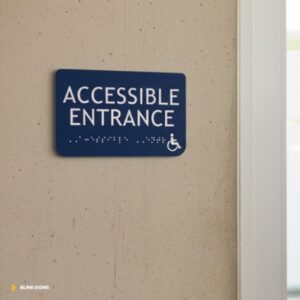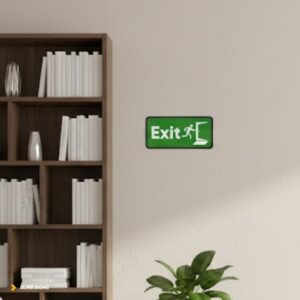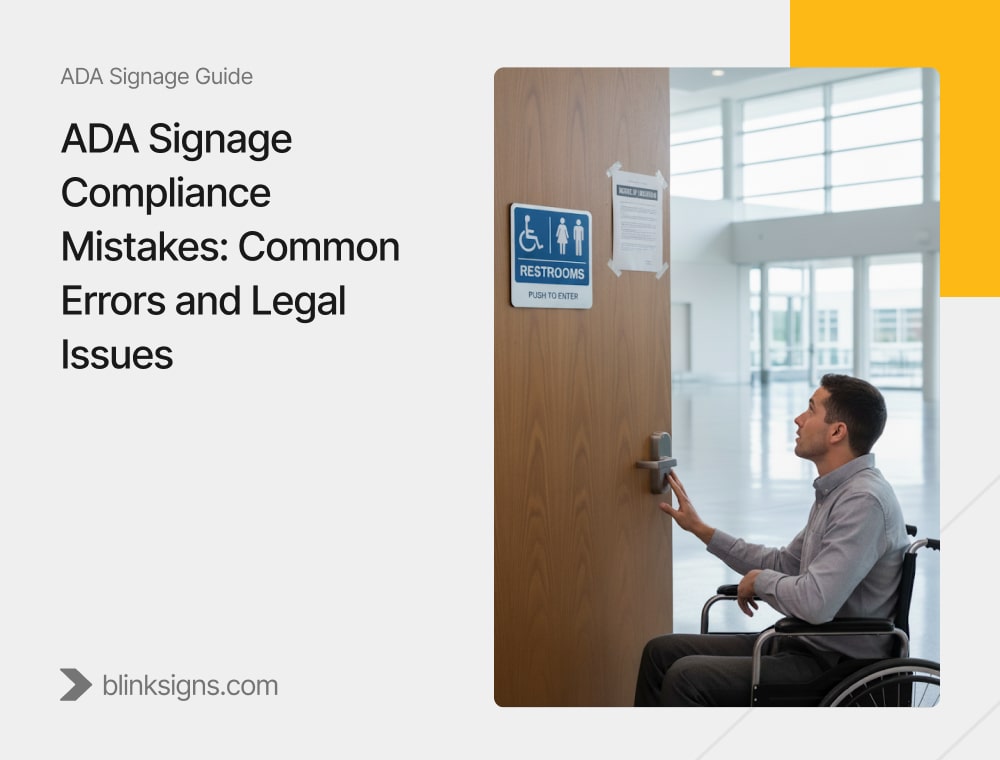
ADA Signage Compliance Mistakes: Common Errors and Legal Issues
Why “Small” Signage Errors Create Big Legal Risk
Building inspectors, advocacy groups, or plaintiffs’ attorneys typically notice ADA signage when it’s incorrect. The stakes are high for facility leaders, general contractors, and operators with many locations: a wrongly placed restroom sign, missing Grade 2 Braille, or a shiny finish can lead to failed inspections, legal problems under Title III, and urgent repairs that often have tight deadlines.
The financial ripple effects extend well beyond a citation: rushed re-fabrication and re-installation across dozens of rooms, operational disruptions, and reputational harm in the disability community.
BlinkSigns has audited thousands of facilities across retail, healthcare, hospitality, education, and multi-tenant portfolios. The same mistakes keep appearing: door-mounted tactile signs, the wrong mounting height (measured to the sign top instead of the lowest Braille line), non-glare violations, and decorative fonts used on tactile characters.
Many teams don’t anticipate the following legal acceleration—DOJ enforcement authority under ADA Title III, private-party lawsuits with attorney’s fees, and, in some states, additional statutory damages (e.g., California’s Unruh Act).
This ADA signage compliance mistakes guide focuses on mistakes-first coverage with a practical legal and prevention lens: the actual cost of non-compliance, how enforcement plays out, and exactly which errors inspectors flag most. Parts 2–3 dig into the “Top 12 Mistakes,” state overlays (CA/TX/NY), inspection tactics, and a prevention playbook you can apply immediately—plus checklists, tables, and documentation tips to pass inspection the first time.
The High Cost of ADA Signage Non-Compliance
Federal Penalties & Legal Consequences (Title III, DOJ)
- Civil penalties: “$75,000 base penalty (adjusted to $115,231 first and $230,464 subsequent as of 2024 DOJ inflation update)”
- Injunctive relief: mandatory corrections with court oversight (consent decrees may require audits, reporting, and training).
- Attorney’s fees: prevailing plaintiffs can recover reasonable fees; businesses often pay their own defense costs even in settlements.
- “Pattern or practice” findings: can elevate scrutiny and expand remedial scope across multiple sites.
- Ongoing violations: continue to accrue risk until corrected and verified.
Beyond Fines: Hidden Business Costs
- Remediation & Replacement: re-fabrication ($75–$300/sign), rush fees (25–50%), reinstallation labor, permitting, and re-inspection.
- Operational Disruption: access restrictions during retrofits; delays to the Certificate of Occupancy for new builds.
- Reputation & Revenue: negative visibility in disability communities and local media; customer attrition.
- Insurance & Transactions: premium impacts; deal friction in sales/lease due diligence when violations surface.
Penalty & Cost Matrix (Quick Reference)
| Cost Type | Typical Range | What Triggers It | Notes |
| DOJ Civil Penalty (Fed.) | $75,000 (first) · $150,000 (subsequent) | Title III enforcement | Separate from private settlements/fees. |
| Private Settlement | $10,000–$50,000 | Demand letters/lawsuits | Often includes attorney’s fees + remediation terms. |
| Defense Legal Fees | $15,000–$75,000 | Contested cases | Even “quick” resolutions incur meaningful costs. |
| Re-fabrication & Install | $75–$300 per sign + labor | Non-compliant design/placement | Higher for custom materials or large programs. |
| Rush/Expedite Premium | +25–50% | Tight deadlines (CO holds, consent decrees) | Common for multi-site corrections. |
| Re-inspection & Admin | $500–$2,500+ | Jurisdiction-dependent | Includes documentation and scheduling. |
| Reputation/Revenue Loss | Variable | Public complaints, accessibility PR | Hard costs + brand damage. |
(Ranges reflect industry norms and program experience; actual costs vary by jurisdiction, portfolio size, and complexity.)
Real-World Lawsuit & Enforcement Patterns (What We See in the Field)
- Serial litigation & advocacy pressure: Certain jurisdictions (e.g., CA/NY/FL) experience higher filing volume; repeat plaintiffs and specialized firms focus on high-traffic public accommodations.
- Signage-specific triggers: Door-mounted tactile signs, missing Grade 2 Braille, glossy finishes, and incorrect mounting height are frequent first-wave claims because they are visible and easy to prove.
- Portfolio effect: One location’s citation or claim often expands into multi-site reviews, increasing remediation scope and cost.
- Consent decree obligations: Beyond correcting the signs, organizations may be required to complete audits, adopt standard operating procedures, and submit verification reports for a set period.
- State overlays: In California, Unruh Act statutory damages (per visit) can compound exposure even when federal ADA penalties don’t apply to private action.
“According to 2024 DOJ filings, So Cal Equal Access Group alone filed 2,598 signage-related cases.”
What To Do Before It Becomes Legal
- Run a targeted signage audit (focus on doors/rooms, height baselines, non-glare finishes, Braille correctness, pictogram field).
- Document everything (photos, measurements to the lowest Braille line, contrast checks, and installation dates).
- Fix high-risk errors first (door-mounted tactile, wrong height, missing Braille, glossy finishes).
- Prepare an inspector-ready packet (sign schedule, specs, code references, and QC results).
- Align multi-state standards (separate packs for CA/TX/NY to avoid failing state-level rules).
Top 12 ADA Signage Compliance Mistakes
Mistake #1 — Incorrect Mounting Height
The Violation: Signs installed outside the 48–60 inch AFF range (measured to the lowest Braille line).
Why It Matters: Improper height restricts accessibility for wheelchair users and fails ADA 703.4.1 requirements.
Common Scenarios: Eye-level installations (~66 inches), measuring to the sign top instead of the tactile baseline.
BlinkSigns Solution: Laser-level measurement verified to tactile baseline, ensuring all signs fall within 48–60 inches AFF.
Mistake #2 — Mounting Signs Directly on Doors
The Violation: Tactile identification signs are placed on moving doors instead of the latch-side wall.
Why It Matters: Creates safety hazards; users must enter the door swing path to read.
Common Scenarios: Double-door confusion or limited wall space.
BlinkSigns Solution: Latch-side placement templates with verified clear-floor-space (18″×18″) access zone.
Mistake #3 — Missing or Incorrect Braille
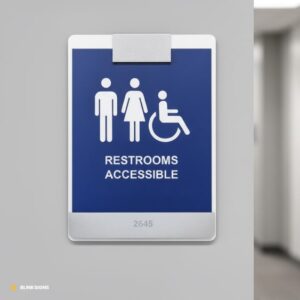
The Violation: Flat-printed “Braille,” wrong Grade, spacing errors, or omission.
Why It Matters: Eliminates tactile navigation for blind users; direct violation of ADA 703.3.
Common Scenarios: Uncontracted Grade 1 Braille, misaligned dots, or no Braille on permanent rooms.
BlinkSigns Solution: Photopolymer production with Grade 2 Braille verification gauges on every batch.
Mistake #4 — Lowercase Tactile Characters
The Violation: Sentence-case or lowercase letters on tactile text.
Why It Matters: Reduces tactile legibility; only uppercase tactile letters comply.
Common Scenarios: Brand style guides forcing mixed-case typography.
BlinkSigns Solution: Dual-layer design: uppercase tactile copy paired with visually branded sub-text beneath.
Mistake #5 — Poor Contrast Between Text and Background
The Violation: Insufficient light–dark contrast; non-glare rule violations.
Why It Matters: Prevents low-vision users from reading; fails ADA 703.5.1 intent.
Common Scenarios: Beige-on-white, mid-tone grays, or color-blind-unfriendly red/green.
BlinkSigns Solution: “While ADA standards define only ‘high contrast,’ BlinkSigns verifies a minimum 4.5:1 contrast ratio (WCAG 2.1 reference) for measurable compliance.”
Mistake #6 — Decorative or Non-Compliant Fonts
The Violation: Script, italic, or condensed fonts on tactile text.
Why It Matters: Impairs legibility; violates stroke-width ≤ 15% and simple-font requirement.
Common Scenarios: Logo-matched typefaces or design-driven deviations.
BlinkSigns Solution: Use approved sans-serif fonts (Helvetica, Arial, Futura) in tactile zones; decorative fonts are limited to visual-only layers.
Mistake #7 — Glossy or Reflective Finishes
The Violation: High-gloss laminates, polished metals, or glass backgrounds.
Why It Matters: Creates glare under artificial light; fails the ADA 703.5.2 non-glare requirement.
Common Scenarios: Metallic brand panels, acrylic laminates.
BlinkSigns Solution: Matte UV-stable coatings with <10 Gloss Units (GU) reflectivity per finish test.
Mistake #8 — Incorrect Tactile Character Height or Depth
The Violation: Characters < ⅝″ or > 2″ high, or raised < 1⁄32″.
Why It Matters: Improper dimension breaks the tactile legibility standard.
Common Scenarios: Scaled fonts or “embossed-print” effects.
BlinkSigns Solution: Precision depth-gauging during production; every letter raised ≥ 1⁄32″ with ±0.005″ tolerance.
Mistake #9 — Improper Pictogram Field Size or Placement
The Violation: Text inside the pictogram area or field under 6″.
Why It Matters: Violates ADA 703.6 and reduces universal symbol recognition.
Common Scenarios: Small restroom icons, mixed text-symbol layouts.
BlinkSigns Solution: Dedicated 6″ pictogram field minimum with tactile text + Braille below in a separate zone.
Mistake #10 — Wrong Sign Location or Obstructions
The Violation: Signs hidden behind doors, furniture, or fixtures.
Why It Matters: Eliminates clear approach space (18″×18″) and obstructs accessibility.
Common Scenarios: Relocated furniture, vending machines, and wall corners.
BlinkSigns Solution: Field survey mapping furniture zones + red-flag review before final installation.
Mistake #11 — Omitting Required Sign Types
The Violation: Missing room ID, restroom, exit, or elevator signs mandated under Section 216.
Why It Matters: Creates navigation barriers and inspection failures.
Common Scenarios: Staff-only rooms, storage areas, secondary stairwells.
BlinkSigns Solution: Comprehensive Section 216 scoping audit with photo-verified sign inventory.
Mistake #12 — State-Specific Requirement Violations
The Violation: Meeting federal ADA but missing California (CBC) or Texas (TAS) overlays.
Why It Matters: State laws can impose additional symbols, Braille geometry, and contrast rules.
Common Scenarios: California dual restroom signs were omitted, and Texas dot geometry failed.
BlinkSigns Solution: Pre-production state code cross-check + localized inspection templates for multi-state clients.
👉 Want to avoid these compliance mistakes?
Get our free Checklist of 12 ADA Signage Compliance Mistakes to Avoid (Free PDF) »
ADA Mistake Summary & Correction Table
| # | Mistake | Core Violation / Code Ref. | Risk Level (Inspection) | BlinkSigns Correction |
| 1 | Mounting Height Error | ADA 703.4.1 – Baseline 48–60″ AFF | High | Laser-level AFF verification |
| 2 | Door Mounting | ADA 703.4.2 – Latch-Side Wall Required | High | Latch-side template install |
| 3 | Missing/Incorrect Braille | ADA 703.3 – Grade 2 Braille Dots | High | Photopolymer Grade 2 Verification |
| 4 | Lowercase Tactile Letters | ADA 703.2 – Uppercase Requirement | Medium | Uppercase Tactile with Visual Sub-Text |
| 5 | Low Contrast / Glare | ADA 703.5.1 + 703.5.2 | High | 4.5 : 1 Contrast + Matte Finish |
| 6 | Decorative Fonts | ADA 703.2 – Legibility Rules | Medium | Sans-Serif ADA Font Library |
| 7 | Glossy Finishes | ADA 703.5.2 – Non-Glare Surface | High | Matte UV Coating (<10 GU) |
| 8 | Wrong Tactile Depth/Height | ADA 703.2 – 1⁄32″ Depth Rule | Medium | Precision Depth Gauge QC |
| 9 | Pictogram Errors | ADA 703.6 – 6″ Field + Separation | Medium | Dedicated Field Layout |
| 10 | Obstructed Placement | ADA 308 + 703.4 Clear Space | High | Furniture Zone Audit |
| 11 | Missing Sign Types | Section 216 – Scope Requirements | High | Full Facility Sign Inventory |
| 12 | State Rule Violations | CBC Title 24 / TAS Ch. 4 | High | State-Code Compliance Review |
Trends & Future Outlook in ADA Signage Compliance (2025–2026)
The landscape of ADA signage enforcement is shifting rapidly. With rising serial litigation and new state-level accessibility initiatives, inspectors and attorneys focus on precision-level compliance, not intent. What used to pass a quick check in 2010 now often fails a check in 2025 because the standards for visual contrast, mounting accuracy, and Braille geometry have gotten stricter.
1. Growing Multi-State Enforcement
- California, Texas, and New York still have the most ADA-related enforcement cases. This is now backed up by local accessibility laws like CBC Title 24, Texas Accessibility Standards (TAS), and New York Human Rights Law (NYHRL).
- Inspectors in these states increasingly require dual sign systems, stricter Braille depth verification, and color contrast testing under controlled light conditions.
- CASp-certified inspections in California are becoming the new norm for facilities before sale, lease, or occupancy certification.
2. DOJ and Private Lawsuit Patterns
- Data from 2024–2025 shows a steady estimated 10–12% increase in Title III physical accessibility cases, based on 2024 field observations and DOJ summaries, many triggered by signage violations during accessibility audits.
- Serial plaintiff law firms (e.g., So Cal Equal Access Group, Stein Saks) have filed over 2,500 signage-related cases annually, often targeting retail and hospitality locations.
- Expect expanded pattern-or-practice enforcement where a single violation can open audits across all properties under the same ownership.
3. Technology & Verification Evolution
- Inspectors increasingly use digital measurement apps, contrast luminance meters, and Braille verification gauges to confirm compliance on-site.
- Modern manufacturers like BlinkSigns have integrated precision photopolymer processes, laser-guided cutting, and state-specific compliance presets into their production workflows.
- Expect greater use of QR-coded compliance certificates on signage backs linking to digital inspection data and installation verification records.
- While over 8,800 digital accessibility lawsuits were filed in 2024 (a 7% increase YoY), physical signage non-compliance remains a primary enforcement driver for brick-and-mortar facilities.
4. Preventive Compliance as ROI
Organizations that do annual ADA audits see up to a 90% drop in the risk of failing inspections and get back $10 for every $1 spent by avoiding legal fees, downtime, and emergency fixes.
This proactive approach is becoming a competitive differentiator, demonstrating corporate responsibility and inclusivity while safeguarding operational continuity.
The BlinkSigns Advantage: From Audit to Verified Compliance
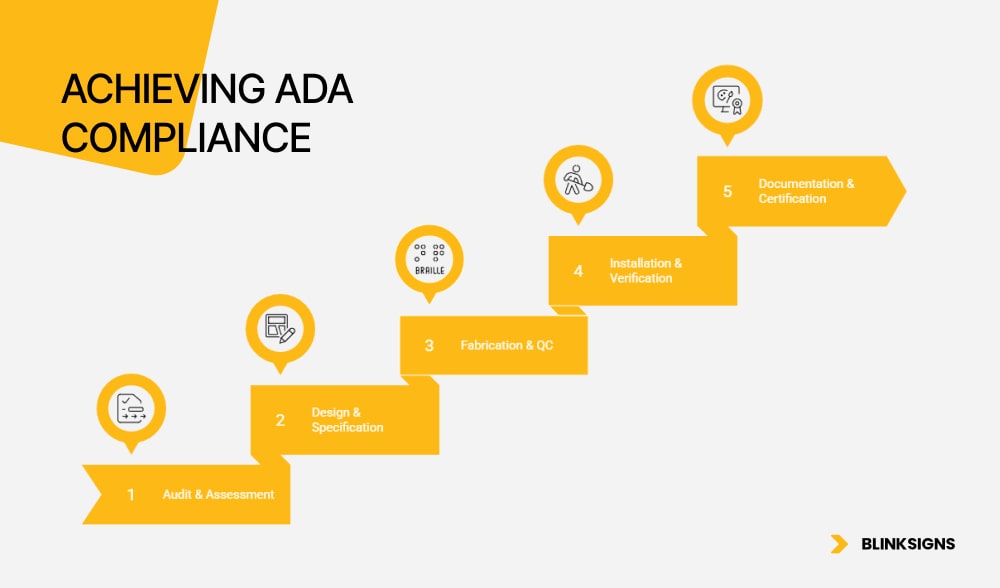
Achieving ADA Compliance – Infographics
BlinkSigns’ ADA compliance program was built to eliminate the most common inspection failures before they occur. Whether for a single property or a national rollout, our process aligns with 2010 ADA Standards, CBC, TAS, and ANSI A117.1 requirements verified through a documented multi-step workflow.
Our End-to-End ADA Compliance Process
| Phase | Description | BlinkSigns Expertise |
| 1. Audit & Assessment | On-site evaluation identifying mounting, contrast, and tactile errors | Certified ADA inspectors with field measurement verification |
| 2. Design & Specification | Code-based design aligned with brand and accessibility | Photopolymer, acrylic, and metal fabrication with Grade 2 Braille verification |
| 3. Fabrication & QC | In-house production with depth, contrast, and Braille spacing validation | Non-glare finishes and laser depth measurement at 1/32″ precision |
| 4. Installation & Verification | Installation within 48–60″ AFF, latch-side placement, clear-floor verification | Trained field teams following ADA 703.4 placement standards |
| 5. Documentation & Certification | Digital compliance packet with measurements and inspection photos | Inspector-ready verification package with QR-based certification |
BlinkSigns’ ADA program integrates compliance assurance with design flexibility, ensuring every sign meets legal standards and reinforces the client’s visual identity.
FAQs:
Q1: What are the most common ADA signage mistakes?
Incorrect mounting height, missing Grade 2 Braille, and door-mounted tactile signs remain the top three violations nationwide.
Q2: How much can ADA signage violations cost?
Federal penalties reach $75,000 for a first offense and $150,000 for subsequent violations, plus legal fees, settlements, and reinstallation costs.
Q3: Can a business be sued for non-compliant signage?
Yes. Under ADA Title III, individuals and advocacy groups can file lawsuits seeking injunctive relief and attorneys’ fees.
Q4: Do restroom signs require Braille?
Yes. All permanent room identification signs, including restrooms, must include Grade 2 Braille beneath tactile text.
Q5: What height should ADA signs be mounted?
Measure to the lowest Braille line, ensuring it sits 48–60 inches above the finished floor (AFF).
Q6: Are glossy finishes ADA-compliant?
No. Glossy or reflective materials violate ADA 703.5.2. Signs must use matte, non-glare surfaces.
Q7: What fonts are allowed on tactile signs?
Only sans-serif or simple serif fonts with clean stroke widths (10–30% of character height). Decorative or italic fonts are not compliant.
Q8: How often should facilities audit ADA signage?
The requirement should be met at least annually,” reads slightly awkward; suggest “Facilities should conduct audits at least annually.
Q9: What triggers ADA inspections?
Building occupancy reviews, accessibility audits, or public complaints typically initiate inspections.
Q10: Do state laws differ from federal ADA rules?
Yes. California, Texas, and New York add stricter requirements on Braille geometry, restroom signage, and contrast standards.
Q11: What happens after an inspection failure?
Facilities typically receive a 30–90 day correction order and must schedule a re-inspection to regain compliance certification.
Q12: Does ADA compliance improve business reputation?
Absolutely. Accessible environments expand market reach and build trust among customers with disabilities.
Protecting Your Business Through Proven Compliance
ADA signage errors aren’t minor oversights but compliance failures with measurable financial, operational, and reputational costs. Each missed baseline, misaligned Braille cell, or glossy finish risks more than inspection failure; it signals inaccessibility.
BlinkSigns ensures your facility avoids that risk through an audit-driven, legally sound, and design-conscious ADA signage process. From code interpretation to field verification, every sign we deliver meets and documents full compliance.
Ready to verify your facility’s ADA compliance?
📞 Contact BlinkSigns for a free compliance audit consultation and ensure your signage program is inspection-ready across all states.
